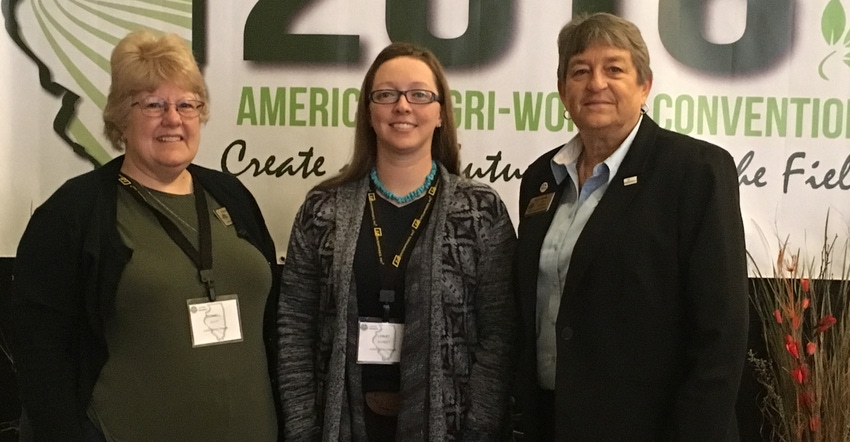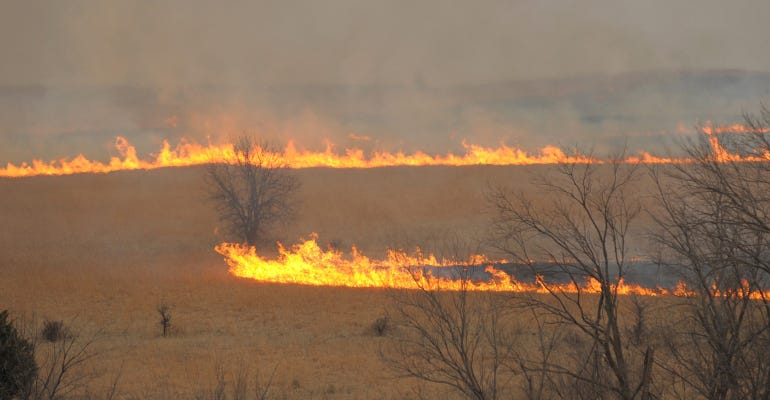
If you glance at just the last three years of national leadership positions, you’d think Kansas Agri-Women are big on education. Lesley Schmidt of Park City was elected as vice president of education for American Agri-Women for the upcoming year, becoming the third Kansan in a row to fill that seat.
She replaces Jean Goslin of Dwight, who served as vice president. Goslin, in turn, took over for Donnell Scott of Manhattan.
If you take a look at overall American Agri-Women history, however; you’d probably arrive at the more accurate conclusion that Kansas Agri-Women are big on leadership.
“Kansas has always been one of the groups willing to step up and get involved,” Goslin says. “Yes, we do have a heavy emphasis on education. Like all ag groups, we have developed a heightened awareness in the past several years about the importance of education consumers about their food. There are so many misconceptions out there that it is a full-time job just getting the word out.”
The vice president of education also oversees projects for Ag in the Classroom; helps with education for members; and leads outreach to college students.
But, Goslin says, if you look back on the history of AAW, Kansas women have been willing leaders in all capacities.
“I think we may be the only state group to have three past national presidents,” she says.
KAW, founded in 1974, was one of the first state affiliates for AAW, and Jean Pettibone of Kanorado was the first Kansas women to lead the national group early on. Jean Mertz and Chris Wilson are also among the past national presidents for AAW.
“Kansas has a strong history of stepping up and taking action on something we believe in,” Goslin says. “And certainly, education is something I believe in.”
For the coming year, Goslin will continue to serve on the education committee and AgDay 365 committee at AAW.
AgDay 365 is an effort that was started to emphasize that one day in March designated as Ag Day is not enough — that for anyone who eats, AgDay is 365 days a year. Goslin says this year's emphasis will be on the problem of wasted food and what can be done to reduce waste from farms, restaurants and supermarkets.
Donnell Scott, who will continue to serve on the education and food labeling committees at AAW, says she thinks of education as outreach in several directions.
“We have a booth at the national Ag in the Classroom convention and at the National FFA convention,” Scott says. “We have also had a major effort to help educate the public with a ‘Drive Across America’ during my term, where we drove across the country, meeting with affiliates and consumers. We also undertook a review of the affiliates’ handbook to make sure that it was up-to-date.”
Scott and Goslin agreed that there is a growing population of women who are primary manages of farming operations.
“In our family, my husband is the one doing the job in town and providing insurance, and I’m the one driving the swather and the rake," Goslin says.
Scott took over management of the farming and cattle operations after her husband died two years ago. She says she continues to work full-time at the American Institute of Baking, where she does food labeling and works to help answer questions that arise on labeling requirements.
As vice president of education at AAW, Schmidt will serve as chairman of the education committee. She is also a board member of the American Agri-Women Foundation and serves as treasurer of that organization. She will also be working on the beef, natural resources, the farm bill task force, land use, membership and communications committees.
In addition to Schmidt, Scott and Goslin, a fourth KAW leader is stepping up to serve on AAW committees. Lynn Woolf of Milton will serve on community relations, communications and Ag Day 365 committees at the national level in 2019.
Woolf was also recognized for her work on those committees and received a President’s Award during the national convention last fall in Springfield, Ill.
At the state level, Kansas Agri-Women focuses on advocacy for agriculture and on ag education. Its motto is, “From Producer to Consumer with Understanding.” Their primary project is providing the highway signs that read “Every Kansas Farmer Feeds 136 People + You” across the state.
Prairie is prairie because of fire
When Kansas Agri-Women held their November meeting in the heart of the Flint Hills in Cottonwood Falls, they invited Chase County Extension agriculture agent Mike Holder to talk about the prairie and the role that fire plays in maintaining it.

PRAIRIE FIRE EDUCATION: Kansas Agri-Women heard an educational program on the importance of fire in maintaining the prairie ecosystem at their November meeting in Cottonwood Falls.

“What research has sown is that, absent fire, the prairie would become a mixed woodland over a relatively short period of time,” Holder said.
Besides fire, maintaining the prairie requires regular grazing by large ruminant animals. Today, cattle largely provide the grazing element, although wildlife such as deer and antelope also participate.
Before white settlement, the great herds of American bison grazed the prairies and the Native Americans routinely burned the grassland, not because they understand the symbiotic relationship of subsoil organisms and sunlight and the renewal of the grass, but simply because they knew the bison herds would arrive to feed on the new green grass.
Regular burning eliminates competitive invasive woody plants such as Eastern red cedar trees and more recent studies have shown that a late summer burn is an effective way to combat the Serecia lespedeza that has taken over some pastures.
Much of what is now the rich farmlands of the Midwest and the Plains was once tallgrass prairie that early settlers plowed under to plant crops in the deep, rich topsoils.
But in the Flint Hills of Kansas, the rocky surface was not conducive to plowing, and the rocks were far too numerous to remove, with more surfacing after every rain.
Now, almost all that remains of the once-vast prairie is in Kansas.
“It’s an ecosystem that is unique and precious,” Holder said. “And it still exists because we graze cattle and burn the grassland.
Following Holder’s talk and their business meeting and working lunch, KAW members toured the history Chase County Courthouse in Cottonwood Falls.
About the Author(s)
You May Also Like






